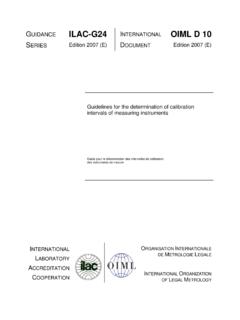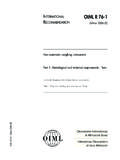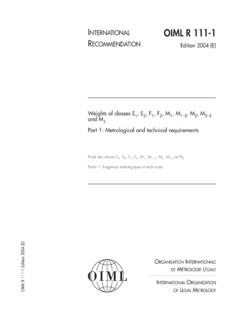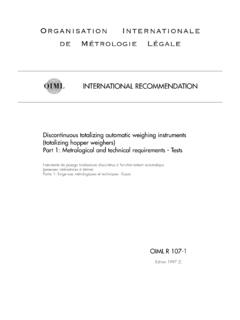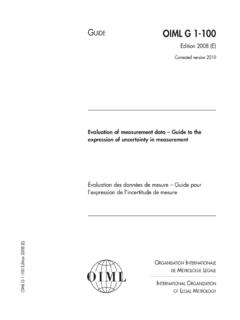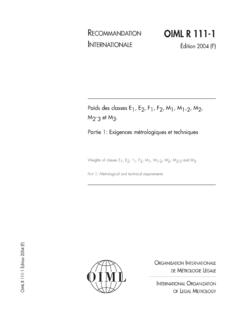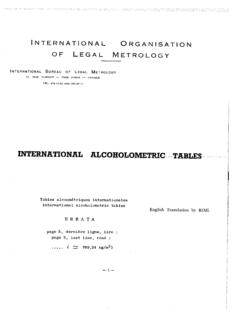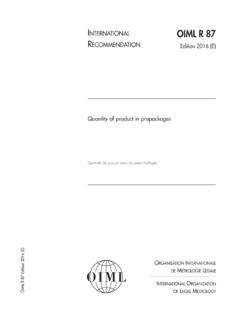Transcription of INTERNATIONAL OIML R 49-1 RECOMMENDATION Edition …
1 Water meters for cold potable water and hot 1: Metrological and technical requirementsCompteurs d eau potable froide et d eau 1: Exigences m trologiques et techniquesOIML R 49-1 Edition 2013 (E)OIML R 49-1 Edition 2013 (E)ORGANISATIONINTERNATIONALEDEM TROLOGIEL GALEINTERNATIONALORGANIZATIONOFLEGALMETR OLOGYINTERNATIONALRECOMMENDATION OIML R 49-1 :2013 (E) Contents Foreword .. 4 1 Scope .. 5 2 Normative references .. 5 3 Terms and 5 Water meter and its constituents .. 5 Metrological characteristics .. 9 Operating conditions .. 11 Test conditions .. 13 Electronic and electrical equipment .. 15 Use of certain terms within the European Economic Area .. 16 4 Metrological requirements .. 16 Values of Q1, Q2, Q3, and Q4 .. 16 Accuracy class and maximum permissible error .. 17 Requirements for meters and ancillary devices .. 19 5 Water meters equipped with electronic devices .. 20 General requirements .. 20 Power supply .. 21 6 Technical requirements.
2 22 Materials and construction of water meters .. 22 Adjustment and correction .. 23 Installation conditions .. 23 Rated operating conditions .. 24 Pressure loss .. 25 Marks and inscriptions .. 25 Indicating device .. 27 Protection devices .. 30 7 Metrological controls .. 31 Reference conditions .. 31 Type evaluation and approval .. 31 Initial verification .. 36 Annex A (Mandatory) Performance tests for water meters with electronic devices .. 38 Annex B (Mandatory) Checking facilities .. 40 Annex C (Informative) Permissible errors in service and subsequent verification .. 44 3 OIML R 49-1 :2013 (E) Foreword The INTERNATIONAL Organization of Legal Metrology (OIML) is a worldwide, intergovernmental organization whose primary aim is to harmonize the regulations and metrological controls applied by the national metrological services, or related organizations, of its Member States. The main categories of OIML publications are: INTERNATIONAL Recommendations (OIML R), which are model regulations that establish the metrological characteristics required of certain measuring instruments and which specify methods and equipment for checking their conformity.
3 OIML Member States shall implement these Recommendations to the greatest possible extent; INTERNATIONAL Documents (OIML D), which are informative in nature and which are intended to harmonize and improve work in the field of legal metrology; INTERNATIONAL Guides (OIML G), which are also informative in nature and which are intended to give guidelines for the application of certain requirements to legal metrology; INTERNATIONAL Basic Publications (OIML B), which define the operating rules of the various OIML structures and systems; and OIML Draft Recommendations, Documents and Guides are developed by Project Groups linked to Technical Committees or Subcommittees which comprise representatives from OIML Member States. Certain INTERNATIONAL and regional institutions also participate on a consultation basis. Cooperative agreements have been established between the OIML and certain institutions, such as ISO and the IEC, with the objective of avoiding contradictory requirements.
4 Consequently, manufacturers and users of measuring instruments, test laboratories, etc. may simultaneously apply OIML publications and those of other institutions. INTERNATIONAL Recommendations, Documents, Guides and Basic Publications are published in English (E) and translated into French (F) and are subject to periodic revision. Additionally, the OIML publishes or participates in the publication of Vocabularies (OIML V) and periodically commissions legal metrology experts to write Expert Reports (OIML E). Expert Reports are intended to provide information and advice, and are written solely from the viewpoint of their author, without the involvement of a Technical Committee or Subcommittee, nor that of the CIML. Thus, they do not necessarily represent the views of the OIML. This publication reference OIML R 49-1:2013 (E) was developed by a joint OIML/ISO/CEN working group comprising OIML TC 8/SC 5 Water meters, ISO/TC 30/SC 7 Volume methods including water meters and CEN/TC92 Water meters.
5 The content is the same in substance as that of ISO 4064-1:2014 Water meters for cold potable water and hot water. This Edition supersedes OIML R 49-1:2006 and was approved for final publication by the INTERNATIONAL Committee of Legal Metrology at its 48th meeting in Ho Chi Minh City, Viet Nam in October 2013. It will be submitted to the INTERNATIONAL Conference on Legal Metrology in 2016 for formal sanction. OIML Publications may be downloaded from the OIML web site in the form of PDF files. Additional information on OIML Publications may be obtained from the Organization s headquarters: Bureau INTERNATIONAL de M trologie L gale 11, rue Turgot - 75009 Paris - France Telephone: +33 1 48 78 12 82 Fax: +33 1 42 82 17 27 E-mail: Internet: 4 OIML R 49-1 :2013 (E) Water meters for cold potable water and hot water. Part 1: Metrological and technical requirements 1 Scope This part of OIML R 49 specifies the metrological and technical requirements for water meters for cold potable water and hot water flowing through a fully charged, closed conduit.
6 These water meters incorporate devices which indicate the integrated volume. In addition to water meters based on mechanical principles, this part of OIML R 49 applies to devices based on electrical or electronic principles, and mechanical principles incorporating electronic devices, used to measure the volume of cold potable water and hot water. This part of OIML R 49 also applies to electronic ancillary devices. Ancillary devices are optional. However, it is possible for national or regional regulations to render some ancillary devices mandatory in relation to the utilization of water meters. Note: Any national regulations apply in the country of use. 2 Normative references The following documents, in whole or in part, are normatively referenced in this RECOMMENDATION and are indispensable for its application. The latest Edition of the referenced document (including any amendments) applies.
7 OIML R 49-2:2013 Water meters for cold potable water and hot water. Part 2: Test methods. OIML R 49-3:2013 Water meters for cold potable water and hot water. Part 3: Test report format. 3 Terms and definitions For the purposes of this RECOMMENDATION , the following definitions apply. This terminology conforms to that used in OIML V 2-200:2012 (VIM) [1], OIML V 1:2013 [2], and OIML D 11 [3]. Modified versions of some terms defined in References [1] [3] are listed here. Water meter and its constituents water meter instrument intended to measure continuously, memorize, and display the volume of water passing through the measurement transducer at metering conditions Note 1: A water meter includes at least a measurement transducer, a calculator (including adjustment or correction devices, if present) and an indicating device. These three devices can be in different housings. Note 2: A water meter may be a combination meter (see ).
8 Note 3: In this RECOMMENDATION , a water meter is also referred to as a meter . 5 OIML R 49-1 :2013 (E) measurement transducer part of the meter that transforms the flow rate or volume of water to be measured into signals which are passed to the calculator and includes the sensor Note: The measurement transducer may function autonomously or use an external power source and may be based on a mechanical, electrical or electronic principle. sensor element of a meter that is directly affected by a phenomenon, body or substance carrying a quantity to be measured [Source: OIML V 2-200:2012 (VIM) [1] , modified meter replaces measuring system .] Note: For a water meter, the sensor may be a disc, piston, wheel or turbine element, the electrodes on an electromagnetic meter, or another element. The element senses the flow rate or volume of water passing through the meter and is referred to as a flow sensor or volume sensor.
9 Calculator part of the meter that transforms the output signals from the measurement transducer(s) and, possibly, from associated measuring instruments and, if appropriate, stores the results in memory until they are used Note 1: The gearing is considered to be the calculator in a mechanical meter. Note 2: The calculator may be capable of communicating both ways with ancillary devices. indicating device part of the meter that provides an indication corresponding to the volume of water passing through the meter Note: For the definition of the term indication , see OIML V 2-200:2012 (VIM) [1], adjustment device part of the meter that allows an adjustment of the meter such that the error curve of the meter is generally shifted parallel to itself to fit in the envelope of the maximum permissible errors Note: For the definition of the term adjustment of a measuring system , see OIML V 2-200:2012 (VIM) [1], 6 OIML R 49-1 :2013 (E) correction device device connected to or incorporated in the meter for automatic correction of the volume of water at metering conditions, by taking into account the flow rate and/or the characteristics of the water to be measured and the pre-established calibration curves Note 1.
10 The characteristics of the water, temperature and pressure, may be either measured using associated measuring instruments or stored in a memory in the meter. Note 2: For the definition of the term correction , see OIML V 2-200:2012 (VIM) [1], ancillary device device intended to perform a specific function, directly involved in elaborating, transmitting or displaying measured values Note 1: For the definition of measured value , see OIML V 2-200:2012 (VIM) [1], Note 2: The main ancillary devices are: a) zero-setting device; b) price-indicating device; c) repeating indicating device; d) printing device; e) memory device; f) tariff control device; g) pre-setting device; h) self-service device; i) flow sensor movement detector (for detecting movement of the flow sensor before this is clearly visible on the indicating device); j) remote reading device (which may be incorporated permanently or added temporarily). Note 3: Depending on national legislation, ancillary devices may be subject to legal metrological control.
